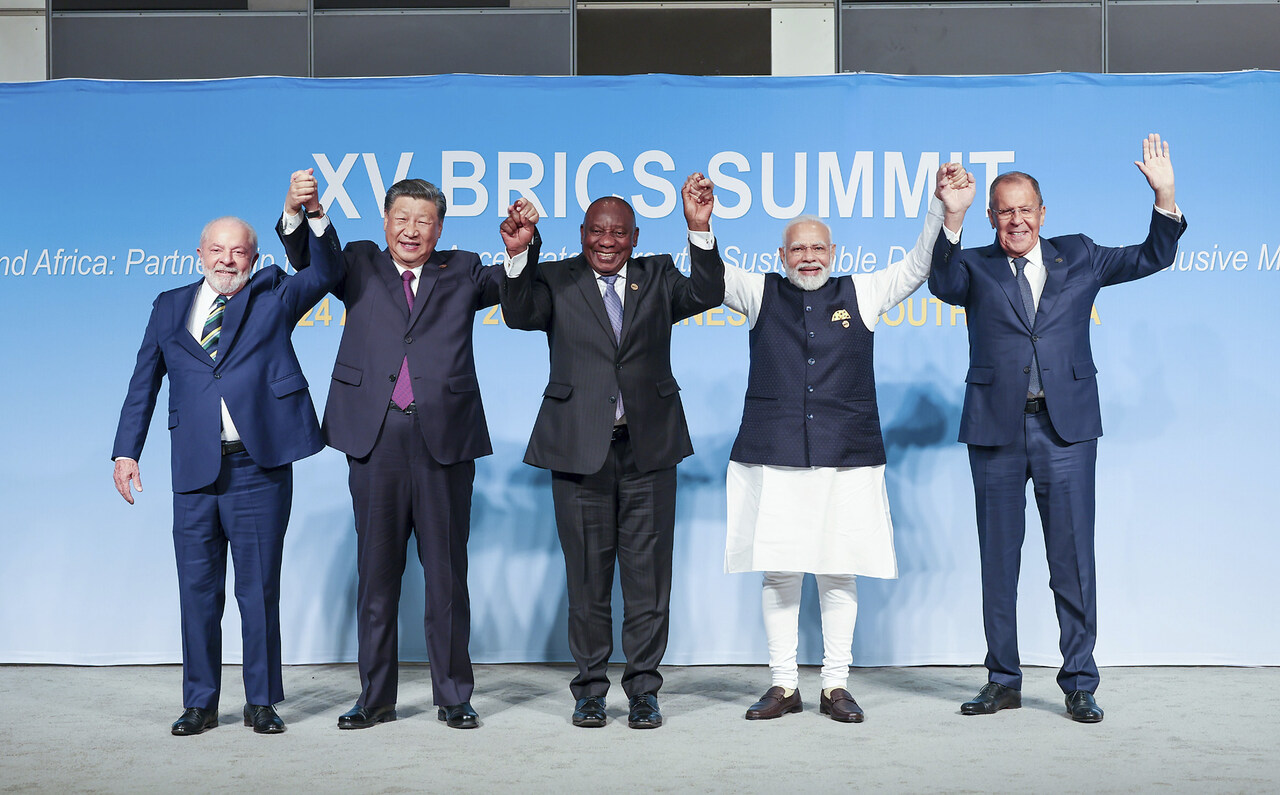India Prioritises Migration in Relations with the EU and Other States
India is the most populous country in the world and has the largest diaspora, giving it an important role in international migration. This country is trying to open foreign markets to Indian migrants more widely by promoting itself as a source of specialists and talent needed by other economies. The issue of legal migration of workers has become a key dimension of cooperation with developed countries and in negotiations of trade agreements, including with the EU. Poland can enter into a dialogue with India on migration to better manage employee mobility and use it to strengthen its own economy and bilateral relations.
 DANIEL KRAMER / Reuters / Forum
DANIEL KRAMER / Reuters / Forum
A “Human Resource Power”
According to UN estimates, India’s population exceeded 1.425 billion people in 2023, overtaking China as the world’s most populous country. Indian society is also one of the youngest on a global scale at an average age of 28.7 years, much younger than, for example, China or the USA (38.5), Poland (41.9), or Germany (47.8). To provide employment for so many young people, 10-12 million jobs must be created each year. Although the official unemployment rate in 2022 was only 7.3%, it was 23% among people aged 15-24 and as much as 42.3% among university graduates aged up to 25. At the same time, only half of the population has qualifications sought in the domestic labour market. Hence, one of the Indian government’s strategies in the fight against unemployment is to support emigration. As such, Prime Minister Narendra Modi promotes India as a “human resource power”—a source of talent and employees for the ageing societies of developed countries.
India already has the largest diaspora in the world. According to the UN, in 2020, 17.9 million Indian citizens lived outside of the country, giving it 6% of the total number of 281 million emigrants in the world (second are Mexicans at 11.2 million). However, the number of emigrants constitutes only 1.3% of India’s population. Every year, 300,000-500,000 people emigrate from the country. According to the Indian authorities, the diaspora (including Indian citizens and people of Indian origin) numbers more than 32 million. These Indians live mainly in the Persian Gulf countries (e.g., 3.5 million in the UAE, 2.5 million in Saudi Arabia), the United States (2.7 million), as well as in Canada, Australia, and Europe.
According to Eurostat, at the end of 2021, 618,000 Indian citizens lived legally in the EU, which was the 10th largest group of foreigners out of the 22.3 million people living in the community from outside the EU. However, there is a clear upward trend: in 2022 alone, 183,000 Indians were given “first residence permits” in the EU, most of them in Germany (35,800), Ireland (18,400) and Poland (17,200). Indians most often reach Europe legally and are among the nationalities receiving the most visas to the EU. In 2022, 541,000 Schengen visas were issued in India, the second most behind Turkey (645,000) and Russia (604,000). At the same time, Indians were the 10th largest group in terms of the number of decisions to return from the EU (15,650).
Dimensions of Migration Policy
India does not have an official document defining its migration policy. The authorities’ actions are focused on improving the situation and using the potential of Indian emigrants abroad, rather than bringing foreigners to India. To enter India, all foreigners (except citizens of Nepal and Bhutan) must have a visa (in most cases, e-visas). India has one of the most restrictive migration policies in Asia. Foreigners have limited opportunities to work, buy real estate, or run a business. According to the UN, the migrant population in India has decreased from 7.6 million in 1990 to 4.9 million in 2020. They mainly come from neighbouring countries, especially Nepal and Bangladesh.
In 2022, India hosted about 250,000 refugees and asylum seekers, mainly from Sri Lanka (43%), Tibet (34%), Myanmar (14%), and Afghanistan (7%), with the first two national groups having special status as guests of the Indian government. However, the state is not a party to the 1951 Geneva Convention relating to the status of refugees. The controversial amendment to the Citizenship Law of 2019 was explained in humanitarian terms, as was the facilitation of the naturalisation of members of persecuted religious minorities (e.g., Hindus and Buddhists) from Afghanistan, Pakistan, and Bangladesh, although this was criticised as discriminatory towards Muslims.
The focus in migration policy on the Indian diaspora results from, among others, the desire to use it to accelerate India’s economic development, including attracting capital and technology. There is a special Division for diaspora engagement in the Indian Ministry of External Affairs (until 2016, there was a separate Ministry of Overseas Indian Affairs). It is responsible for organising economic emigration, maintaining cultural links with the homeland and encouraging emigrants to work for the development of India. India’s primary benefit from having such a large diaspora is the largest amount of private remittances in the world. In 2022, Indian workers sent $111 billion to their home country, almost twice as much as second-place Mexico ($61 billion). This represented over 3.3% of India’s GDP and accounted for over an eighth of all remittances in the world and totalling $787 billion. It also meant a more than five-fold nominal increase compared to 2005 when the value of Indian remittances amounted to $22 billion. In addition, special incentives are intended to encourage diaspora members to invest in India and transfer knowledge and technology, reversing the former “brain drain” trend.
The diaspora is also perceived as a factor strengthening relations with the host country and a source of soft power and building a positive image of India in the world. Large meetings with Indian diaspora members have become a regular element of Prime Minister Modi’s foreign visits. However, there are cases when the diaspora may become a source of deterioration in interstate relations. The latest example is India’s relationship with Canada. Its official accusations against Indian intelligence as being involved in the murder of a Canadian Sikh, as well as the Indian government’s allegations that Canada supports Sikh separatism, led to a serious crisis in bilateral relations. Such a large diaspora also becomes a challenge when crises break out in various parts of the world, requiring the evacuation of citizens, which occurred, for example, during Russia’s aggression against Ukraine in 2022 (Operation Ganga) or the Hamas-Israel war this year (Operation Ajay).
International Cooperation
In foreign policy, India seeks to ensure the security of its citizens, protect workers’ rights and facilitate legal migration. Hence, in recent years, it has been making efforts to sign Social Security Agreements for foreign workers (SSA) and on Migration and Mobility Partnerships (MMPA). India has 20 SSAs, including with Germany, France, Hungary and Czechia. MMPA agreements regulate the conditions for legal round-trip mobility, not only of employees but also of students and scientists in exchange for cooperation in combating illegal migration (e.g., in the field of readmission). India has signed agreements recently with Australia (2023), Germany (2022), the UK (2021), and France (2018). It also declared readiness to negotiate similar agreements with several other countries, including with many states in Europe.
Opening the markets of developed countries for migration is also an important element of negotiating free trade agreements, including with the EU and the UK. Since 2016, India has been conducting a dialogue on migration and mobility with the EU, with the aim of, among others, improving the conditions for legal migration and cooperation in readmission. Although migration policy is the responsibility of the EU Member States, India wants to make it easier for its employees to provide services throughout the Community at the EU level by, for example, recognizing qualifications and diplomas.
Conclusions and Perspectives
Emigration from India is one of the forms of response to economic challenges, including the lack of a sufficient number and higher quality jobs, as well as a way to attract capital, investments, and technology. Therefore, India will insist on further opening of foreign markets for the legal migration of workers. This issue is becoming a key dimension of India’s international cooperation, especially with developed countries. The lack of concessions from the EU and its Member States regarding the admission of workers from India may become a significant obstacle in the ongoing negotiations of a trade agreement. Better coordination of EU members’ migration policies may also reduce their competition for Indian workers and be a way to fill gaps in their own labour markets. The example of India may prove that maintaining relatively large opportunities for legal migration limits the pressure for irregular migration.
Poland can use cooperation on migration more effectively to strengthen relations with India. For this purpose, it is worth improving the visa issuance process and starting talks on bilateral mobility agreements (SSA and MMP). Regulating labour migration at the state level (e.g., by setting migration quotas) would be more beneficial than leaving it to market forces, and may also increase the attractiveness of cooperation with Poland from India’s perspective.



.jpg)

(1).jpg)